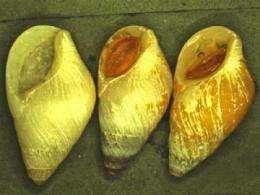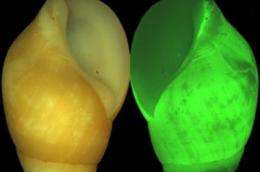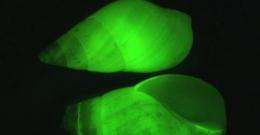Scientists see the light in bizarre bioluminescent snail

Two scientists at Scripps Institution of Oceanography at UC San Diego have provided the first details about the mysterious flashes of dazzling bioluminescent light produced by a little-known sea snail.
Dimitri Deheyn and Nerida Wilson of Scripps Oceanography (Wilson is now at the Australian Museum in Sydney) studied a species of "clusterwink snail," a small marine snail typically found in tight clusters or groups at rocky shorelines. These snails were known to produce light, but the researchers discovered that rather than emitting a focused beam of light, the animal uses its shell to scatter and spread bright green bioluminescent light in all directions.
The researchers, who describe their findings in the Dec. 15 online version of Proceedings of the Royal Society B (Biological Sciences), say the luminous displays of Hinea brasiliana could be a deterrent to ward off potential predators by using diffused bioluminescent light to create an illusion of a larger animal.
In experiments conducted inside Scripps' Experimental Aquarium facility, Deheyn documented how H. brasiliana set off its glow, which he likens to a burglar alarm going off, when the snail was confronted by a threatening crab or a nearby swimming shrimp.

Wilson collected the snails used in the study in Australia and collaborated with Deheyn to characterize the bioluminescence.
"It's rare for any bottom-dwelling snails to produce bioluminescence," Wilson said. "So its even more amazing that this snail has a shell that maximizes the signal so efficiently."
Discovering how the snail spreads its light came as a surprise to the researchers since this species of clusterwink features opaque, yellowish shells that would seem to stifle light transmission. But in fact when the snail produces green bioluminescence from its body, the shell acts as a mechanism to specifically disperse only that particular color of light.

Deheyn says such adaptations are of keen interest in optics and bioengineering research and development industries.
"The light diffusion capacity we see with this snail is much greater than comparative reference material," said Deheyn, of Scripps' Marine Biology Research Division. "Our next focus is to understand what makes the shell have this capacity and that could be important for building materials with better optical performance."
Provided by University of California - San Diego



















